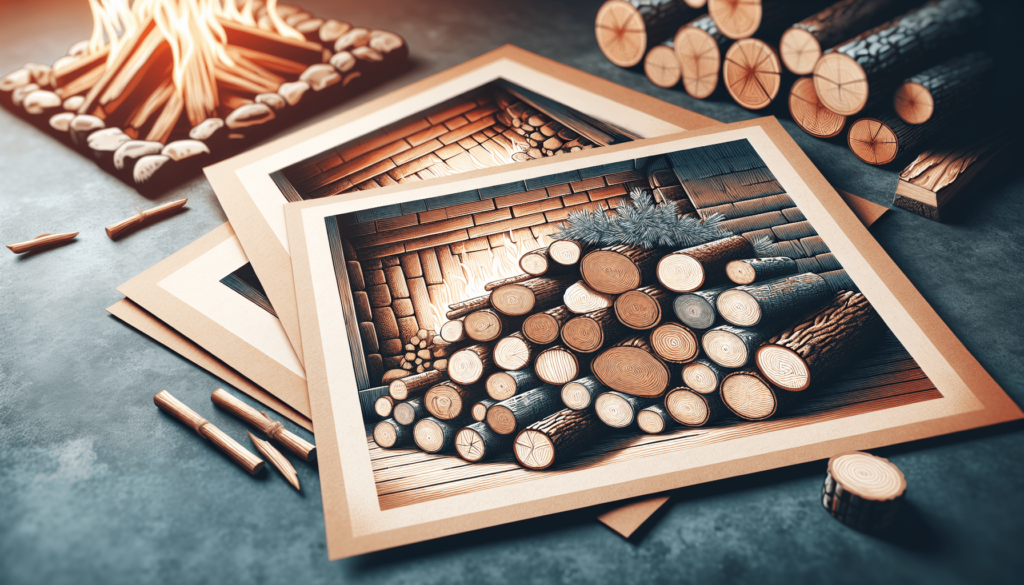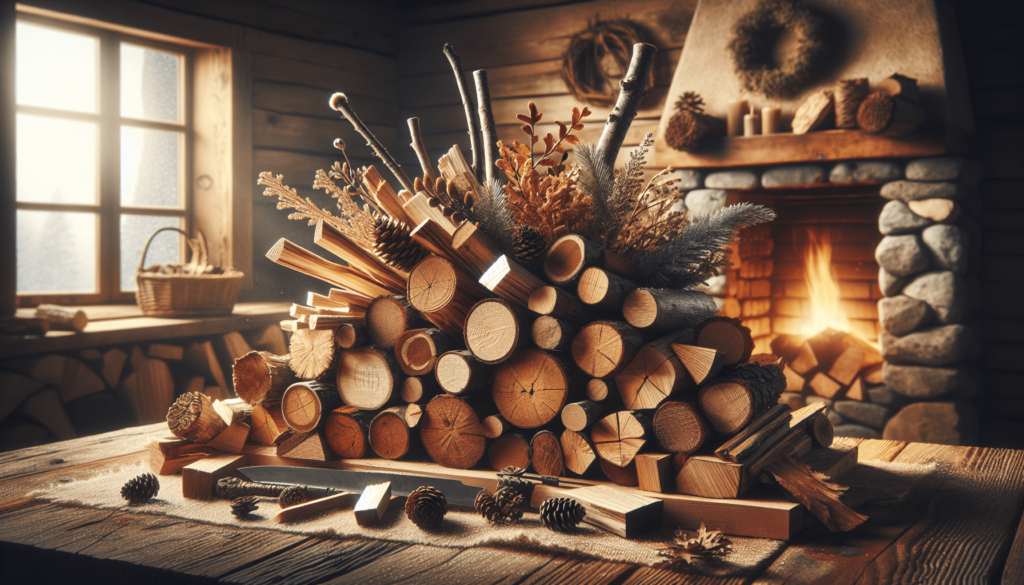Have you ever stood in front of a towering stack of firewood and wondered, “Is this even safe to burn?” Seriously, there’s more to it than just striking a match and calling it a night. Let me walk you through the nuances of selecting the right type of wood for burning, ensuring that your roaring fire is not only warm but also safe and efficient.
Understanding the Basics of Wood Burning
Before I tell you which wood is best, we need to cover some basics. There’s a science to burning wood, much like there’s a science to making perfect scrambled eggs. You can wing it, but why risk failure when you can easily master the fundamentals?
Hardwood vs. Softwood
You’ve probably heard the terms hardwood and softwood thrown around, but what do they mean in the context of burning wood?
- Hardwood: These are typically from deciduous trees, which lose their leaves yearly. They’re denser and burn hotter and longer. Examples include oak, maple, and ash.
- Softwood: These come from evergreen trees, like pine and spruce. Softwoods ignite quickly but burn out faster compared to hardwoods.
| Characteristic | Hardwood | Softwood |
|---|---|---|
| Density | High | Low |
| Burn Duration | Long | Short |
| Heat Output | High | Moderate |
| Usage | Ideal for long-term fires | Great for kindling and short fires |
| Examples | Oak, Maple, Ash | Pine, Spruce |
Moisture Content
Moisture content might sound as dry as, well, dry wood—but it’s crucial. Wood that’s too wet won’t burn well and can lead to creosote buildup in your chimney, a potential fire hazard.
- Green Wood: Freshly cut and can contain up to 50% moisture. Not ideal for burning.
- Seasoned Wood: Dried for at least six months to a year, with around 20% moisture. This is the good stuff.
- Kiln-Dried Wood: Dried in a kiln to below 20% moisture. It burns efficiently but can be pricier.
BTUs: British Thermal Units
BTUs measure the heat content of a fuel source. Different wood types have different BTU values, which determine how effectively they can heat your space.
| Wood Type | BTUs Per Cord (Approx.) |
|---|---|
| Oak | 24-26 million |
| Maple | 24 million |
| Birch | 20 million |
| Pine | 17 million |
| Spruce | 15 million |
Safe Woods for Burning
There are numerous wood types out there, but not all are created equal when it comes to burning. Here are some of the best and safest options for your fireplace.
Oak
- Why Oak? Oak is a hardwood that burns slowly and evenly, producing a substantial amount of heat. It’s king when it comes to fireplace wood.
- Seasoning: Needs to be seasoned for at least a year, sometimes more.
Maple
- Why Maple? Maple is another hardwood that burns cleanly and efficiently. It’s almost as good as oak but often easier to find.
- Seasoning: Similar to oak, it needs about a year to season.
Ash
- Why Ash? Ash has a lower moisture content when freshly cut, so it requires less seasoning. It burns hot and steady.
- Seasoning: About six months to a year.
Birch
- Why Birch? Birch burns quickly and hot but doesn’t last as long as oak or maple. It’s great for immediate heat.
- Seasoning: Needs around six months of seasoning.
Cherry
- Why Cherry? Cherry wood creates a pleasant aroma when burned and provides a decent amount of heat.
- Seasoning: Best when seasoned for at least a year.
Apple and Other Fruitwoods
- Why Use Them? These woods are known for their aromatic smoke, making them a favorite for indoor fireplaces and smokers.
- Seasoning: Needs about a year to season properly.

Woods to Avoid
Just as there are good woods to burn, some woods should be avoided at all costs. These options can be dangerous or problematic for various reasons.
Pine and Other Resinous Woods
- Why Avoid? Pine, spruce, and other softwoods contain high levels of resin, which can lead to creosote buildup in your chimney—a serious fire hazard.
Driftwood
- Why Avoid? Driftwood often contains high levels of salt, which can corrode your fireplace or stove. Burning it can also release toxic chemicals.
Chemically Treated or Painted Wood
- Why Avoid? Burning chemically treated or painted wood releases harmful fumes into your home and the environment. It’s just not worth the risk.
Plywood and Particle Board
- Why Avoid? These woods contain glues and resins that release toxic fumes when burned. Plus, they don’t provide much heat.
| Wood Type | Reason to Avoid |
|---|---|
| Pine, Spruce | High resin content; creosote buildup risk |
| Driftwood | Contains salt, release toxic fumes |
| Chemically Treated Wood | Releases harmful chemicals when burned |
| Plywood, Particle Board | Contains glues/resins; toxic fumes |
Best Practices for Burning Wood
Knowing which wood to burn is half the battle. The other half is how you burn it.
Proper Storage
Storing your firewood correctly ensures it stays dry and ready to burn.
- Covered Storage: Use a wood shed or cover your pile with a tarp.
- Off the Ground: Raise the wood off the ground to prevent moisture absorption.
- Air Circulation: Stack your wood in a crisscross pattern to allow air flow.
Starting a Fire
Getting your fire started can sometimes be the trickiest part. Here are a few tips:
- Use Kindling: Start with smaller pieces of wood or twigs to get the fire going.
- Fire Starters: Use natural fire starters like dryer lint or store-bought options.
- Air Supply: Make sure there’s enough airflow to feed the fire.
Burning Efficiently
A well-burning fire keeps you warm and uses wood efficiently.
- Hot and Fast Start: Start your fire hot and fast to reduce smoke.
- Maintain Heat: Add wood gradually to maintain a steady temperature.
- Chimney Care: Regularly clean your chimney to prevent creosote buildup.

Environmental Considerations
Burning wood is often seen as more eco-friendly compared to fossil fuels, but it’s not without its concerns.
Carbon Footprint
Wood burning releases carbon dioxide, but if you source your wood sustainably, you can minimize your carbon footprint.
- Sustainable Sourcing: Use wood from managed forests or local sources.
- Carbon Neutral: Trees absorb CO2 as they grow, so they offset the CO2 released when burned.
Air Quality
Burning wood can impact air quality, especially if done improperly.
- Reduce Smoke: Burn seasoned wood and maintain a hot fire to reduce smoke.
- Ventilation: Ensure your fireplace has proper ventilation to expel smoke and fumes.
Common Myths and Misconceptions
A lot of misinformation floats around the topic of wood burning. Let’s bust a few myths.
All Wood Burns the Same
Nope. Different woods burn at different rates, have different BTU values, and produce different amounts of smoke.
Softwoods are Bad for All Fires
Not necessarily. Softwoods are great for kindling and fast fires but not ideal for long-term heat.
Green Wood is Okay to Burn
Not if you value efficiency and safety. Green wood is harder to ignite and releases more smoke.
Bigger Logs are Always Better
Large logs burn longer but can smolder if not properly seasoned. Smaller, well-seasoned logs often make for a better fire.
The Financial Aspect of Wood Burning
Burning wood can be economical, but it comes with its own set of costs and responsibilities.
Cost of Wood
- Free Wood: If you have access to your own timber, your primary cost will be time and effort.
- Purchased Wood: Costs vary by region and type, but hardwoods typically cost more than softwoods.
Maintenance Costs
Regular maintenance is crucial for safety and efficiency.
- Chimney Sweeping: Regularly clean your chimney to prevent creosote buildup.
- Fireplace/Stove Maintenance: Inspect and maintain your fireplace or stove to ensure it’s in good condition.
Cost Savings
Burning wood can save you money on heating costs, especially in regions where heating oil or electricity is expensive.
- Supplemental Heating: Use wood burning to supplement other heating methods, thereby reducing overall costs.
- Energy Independence: Rely less on external energy sources, which can be especially valuable during power outages.
Final Thoughts
So there you have it, the ins and outs of what wood is safe for burning. A little knowledge goes a long way in making sure your fire not only warms your home but does so safely and efficiently. Next time you’re stacking that firewood or planning your winter heating, remember these tips. Your fireplace—and your chimney sweep—will thank you.

